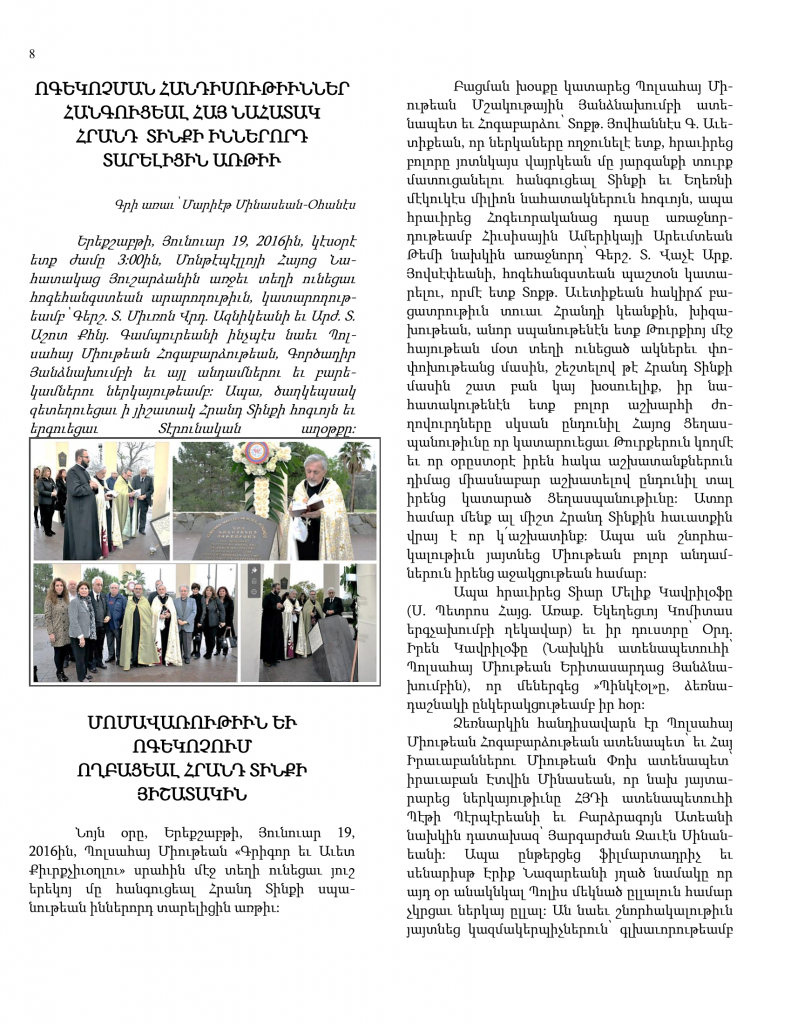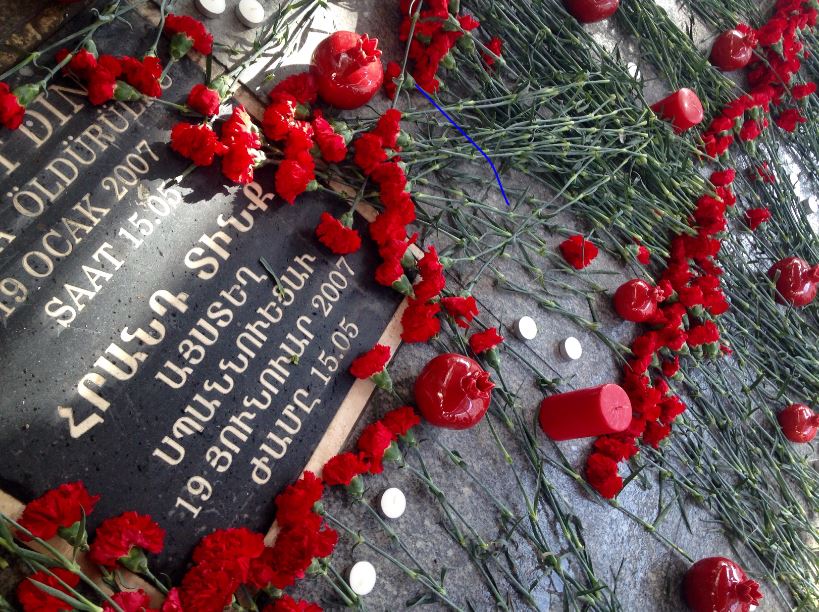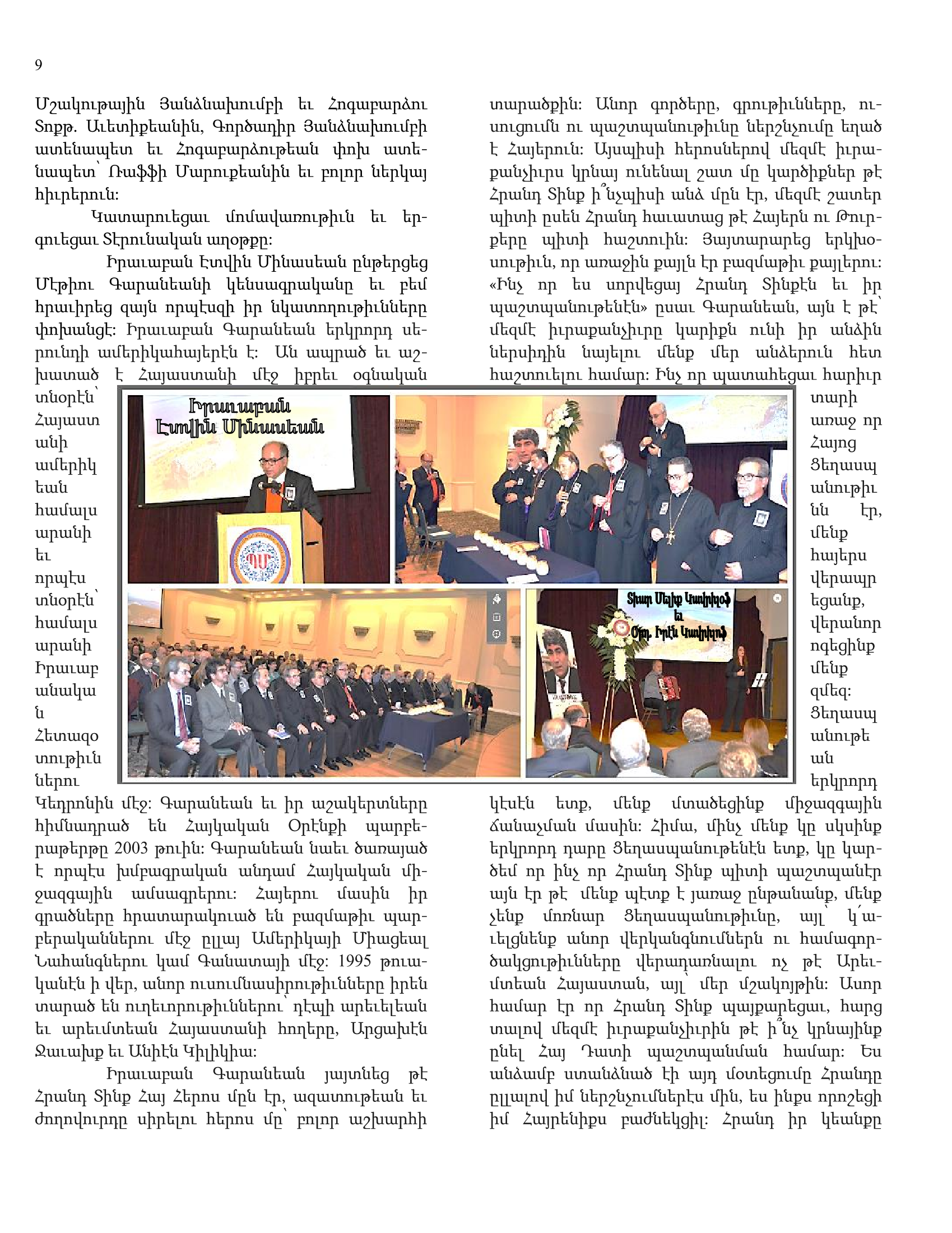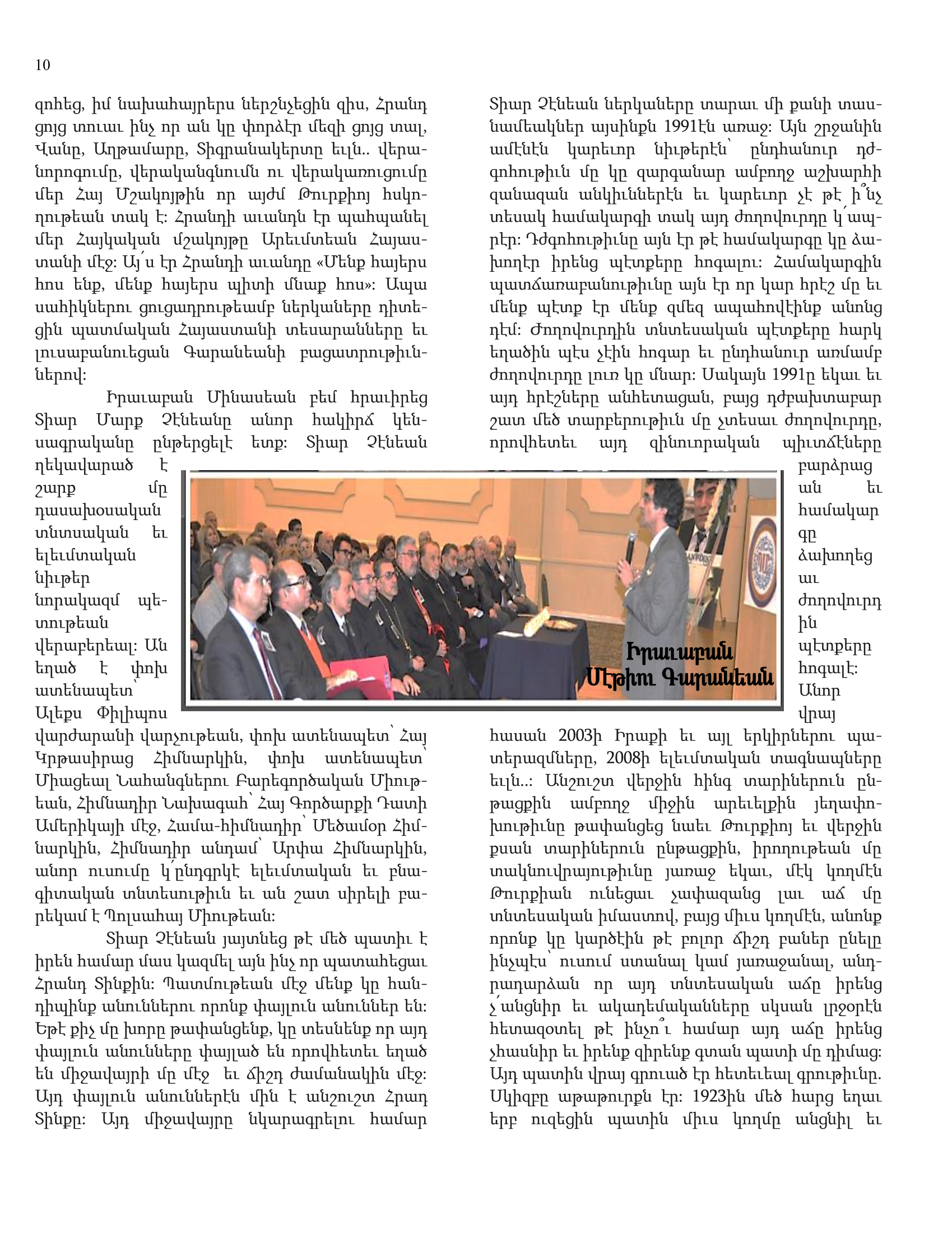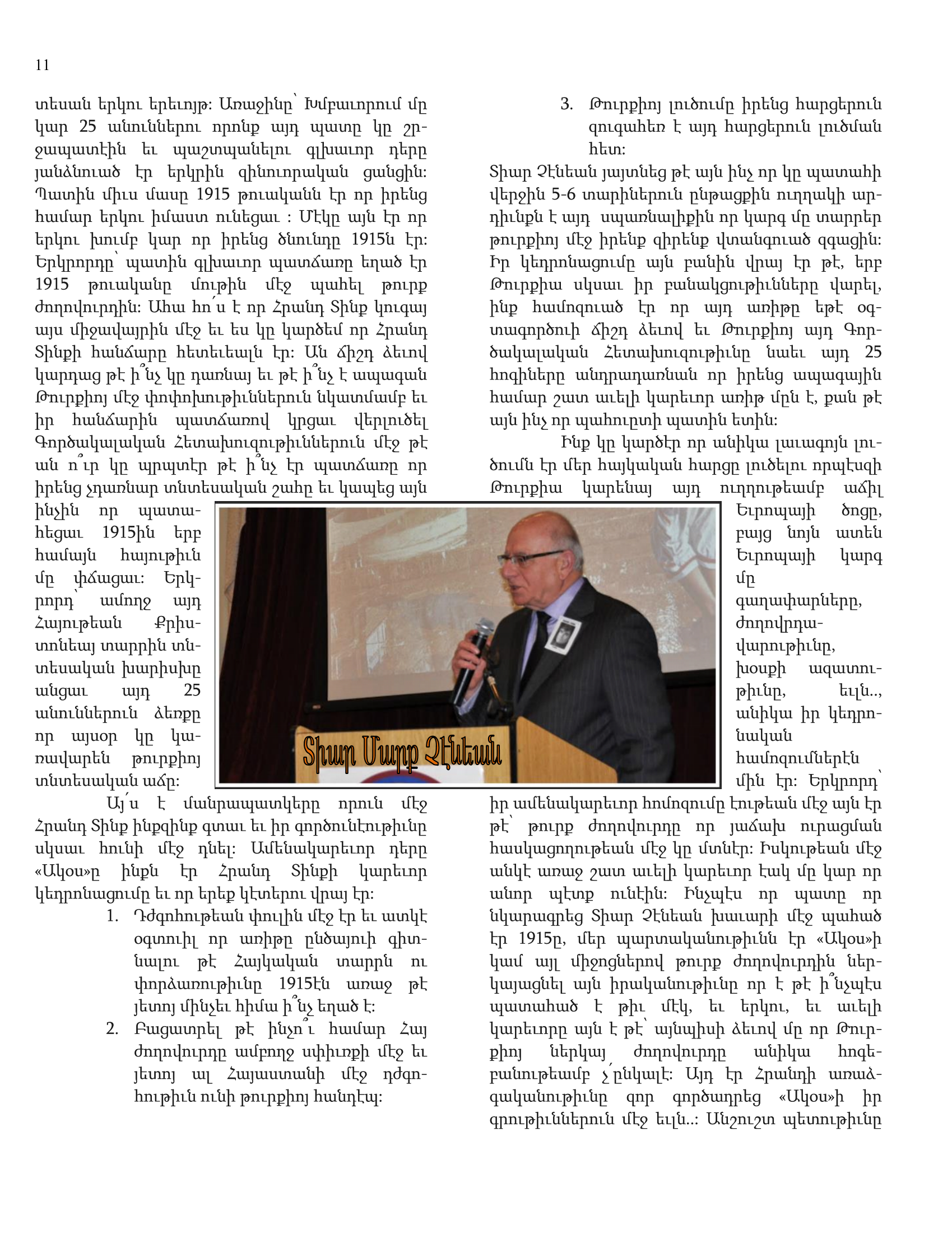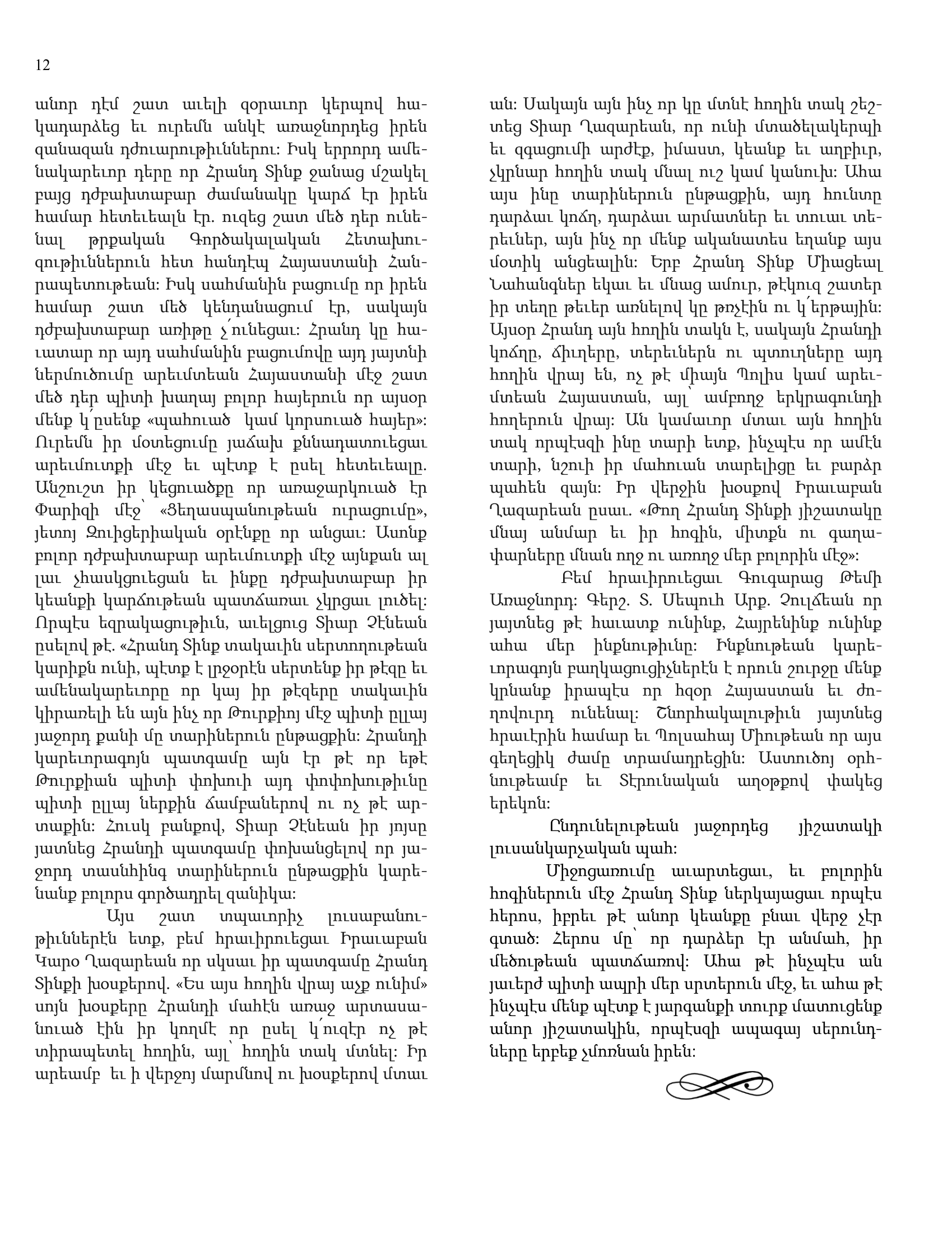
– – – – – – – – –
Photo Albume (Full)
Nazarian: Dink and the Persistence of Hope
A scene from the 2016 Hrant Dink commemoration in Istanbul (Photo: Eric Nazarian)
Dear beloved friends at the Organization of Istanbul Armenians,
I am sorry that I could not be with you this evening. I was looking forward to reuniting with you and collectively commemorating and honoring the everlasting memory and legacy of sourp hoki, Hrant Dink. Due to the recent alarming events unfolding in Turkey and Istanbul that has become a powder keg, I needed to return to Bolis in anticipation of this tragic day of Hrant’s assassination that will be commemorated worldwide.
How can I put into words all that is in my heart as I enter the 6th year of my journeys to Bolis? So much has happened; little has tangibly changed for the better and a lot has been destroyed just in the past six months. The so-called peace process and the dimming promise of a new era of minority rights and any ray of hope for democracy has rapidly eroded into the threat of a new civil war in the southeast. Tragically, the honorable fight for inalienable human rights that Hrant fought so hard for has taken a vicious turn for the worst during these explosive times in Istanbul, Turkey, and the whole of the Middle East.
Just in the past seven weeks, we’ve witnessed the arrest of Can Dundar, the editor-in-chief of Cumhurriyet who exposed the government’s clandestine transfer of weapons to Islamist rebels in Syria; the daylight assassination of Tahir Elci in Dikranagerd, a stone’s toss from Surp Giragos; the suicide bombing in Sultanahmet that killed 11 tourists; and the witch hunt against academics in Turkey protesting the war against the Kurds. As you already know as Bolsahyes, there is never a dull moment in Turkey, except maybe on Kinaliada in the summer, far from the madness of urban Istanbul.
In the thick of this chaos, I wonder and often ask myself, “What would Hrant think of all that is happening?” How would he face these dark days, where people avoid the metros and public spaces for fear of the next suicide bombing? Would he face these days with resolution, panic, or stoicism?
Today is Jan. 19. I am in Bakirkoy looking at the thick white sheets of snow. This is the same snow that has been blanketing this city since time immemorial. It is the same snow that fell on the bones of our nahadags [martyrs]. It is the same snow that knows no time, era, or language. Nine years ago today marked the day of infamy that we will forever return to with rage in our hearts for the justice that is still owed to the legacy and family of Hrant.
Jan. 19, 2007, was the day after April 24, 1915. In the wake of Hrant’s murder, many mused that 92 years had passed since the genocide, and what had changed? Many are still asking these questions nearly a decade later. The answers are far from satisfactory and offer no closure.
A decade ago, Hrant was put on trial for “insulting Turkishness” after exposing the truth behind the lies that formed the bedrock of the national consciousness.
Ten years later, just this past week, we witnessed the vicious crackdown on academics in Turkey exercising the very same rights that Hrant was put on trial for, and that he fought with sincerity and dignity to overcome. These men and women of letters were arrested, censored, fired, and vilified by the state for protesting the brutal war against the Kurds, which has taken countless innocent civilian lives and is on the verge of spiraling into a civil war and humanitarian disaster if not contained soon.
My Kurdish friends tell me that 2015 is fast becoming their 1915. I shudder at the thought and the horrible irony of one century past. A hundred years later and the genocide still haunts this land. The bones are still screaming as more civilians are ambushed and brutally murdered in the crossfire. As the French say, “The more things change, the more they stay the same.”
I first heard the name Hrant Dink around 1997 when I entered my junior year as a USC Film School undergrad. There were occasional articles I came across about an Armenian in Istanbul who had the vision, chutzpah, and focus to start a small newspaper that would be the first public bridge between the Armenian community of Bolis and Turkey. What guts and what stomach this must have taken! What struck me most was the name he chose for the newspaper: AGOS, the focal point where the plough of a farmer meets the earth, creating the space needed for seeds to sprout. What a beautiful idea! What a magnificent word to name a newspaper after.
Why was it so inspiring? Because Hrant was the living validation that, even in the thick of the most unimaginable Spartan odds, one man could dare to follow his conviction to take a stand with the pen and the truth against the swords of denial. The symbolism was too rich and layered with a fierce determination that I was deeply inspired by.
My beloved late grandfather, Hovhannes, had beautiful warm hands that I tilled the garden earth in our backyard in Los Angeles. Every time I hear the word “Agos” to this day, I remember my grandfather’s working hands covered in the fertile earth of the garden. That’s the feeling I return to every time I pick up the newspaper and see the red font on the cover.
Hrant was the living manifestation of the plough that touched the earth and made it fertile with a new hope, a new courage, and a new vision built on his deeply rooted love of being an Armenian, a Christian, and a magnificent family man devoted to his beautiful wife Rakel and their three children Baydzar, Ararat, and Sera.
The earth that Hrant touched and transformed was not ready for the magnitude of his soul and personality, yet its growth depended on Hrant’s touch and devotion. The streets of Istanbul that he loved so dearly were floating with the lingering spirits of the distant and recent tragic Armenian past. Hrant was the working man’s Theseus, ready, willing, and determined to step into the labyrinth of Turkey’s denialist monster machine with his pen, and not the sword. He was the bricklayer, architect, and the gravity of the bridge he struggled so honorably to build by engaging in dialogue and publishing articles that wholeheartedly challenged the official narrative on Armenians and minorities.
Like the truly courageous dreamers and rebels of world history, Hrant didn’t need to roar like a lion in order to prove his courage. Hokov, srdov zulal. He was PURE of heart and conviction. He was always ready to face the odds piling against him with the same courage and conviction that so many can only dream of mustering.
The elders say, “If you want to make God laugh, tell him your plans.” I’ve thought of this saying quite a lot in recent years. The voyages I was blessed to embark on as a filmmaker landed me in one of the most ancient cradles of Armenian culture—Constantinopoli. I first came to Bolis as an angry artist in 2010 determined to make a film about the aftereffects of the Armenian Genocide on the descendants of a survivor who was an oud master. That film became “Bolis.” Six years later, I am still the angry artist, now blessed to return to this city as the son-in-law of the beloved andlusavor Hrant.
Vorteghits vortegh… From Tehran, where my parents hail from, to Armenia, where I was born, to Los Angeles via Columbus, Ohio, and Louisiana, the winds of kismet and Jagatakeer tossed me back across the Atlantic all the way east to this historic, epic, and tortured city. My one foot is in Burbank and the other foot in Bolis. I can hear God laughing really loudly, so I’ve decided to stop telling him my plans.
In the end, there will always be two Hrants for me: The man I looked up to as a faraway older brother, who raised the pen as an instrument of peace and meaningful human dialogue. Then, there is the Hrant who I am now humbled and honored to call my father-in-law.
The pain, the deep feeling of loss for never being able to see him and cherish what it means to be a family will forever be with us, day-to-day, year in, year out.
A scene from the 2016 Hrant Dink commemoration in Istanbul (Photo: Eric Nazarian)
Time does not heal this tragedy or any loss of human life. Time does not heal. Period. What time does do is allow us the space to find the peace within our hearts after a long and extremely painful mourning period. Then the sun will rise again after the darkest hour, and we will rise with the courage to continue the work of our beloveds with the hopes of finding some meaning to their loss and give them peace. This is what I hope to do to honor Hrant every day of my life, not just on Jan. 19.
All of us can grow from this loss and pain through hard work in making the dream of the good and the courageous come true. Perhaps it is no accident that the day before Jan. 19 is Martin Luther King, Jr. Day in the United States.
Hrant and Martin Luther King. They were two unrelated crusaders for peace, one generation and a half a world apart. What has bound them forever is their peaceful fight for the same enduring principles of human and civil rights.
Ironically, after his assassination, they started referring to Hrant as “the Martin Luther King of Turkey.” Sadly, Turkey has yet to meaningfully begin its civil rights era.
The story continues and the torch will no doubt be passed on to the next generation facing the struggles Hrant braved with resolve and absolute commitment. I am honestly no longer sure if there will be a ray of light in the wake of these terrible times that are harkening back to the dark decades of the 1980’s and 1990’s. I hope and pray that I am wrong.
The Pandora’s Box of the war in Syria and Iraq has opened even wider with unimaginable horrors spilling all over the world. From Paris, to Ankara…all the way to San Bernardino County. Nowhere and nothing is untouchable. Courage and hope, now more than ever, will be tested in each and every one of us as we face this incredulous, dangerous, and unpredictable era.
People die daily in Dikranagerd (Diyarbakir) and the coffee shops continue to serve doppio macchiatos in Nisantasi, the newspapers print what they are permitted to, and the country for the most part turns a blind eye to the mushrooming war that is taking innocent lives, left and right.
In the face of this madness, again I wonder what Hrant would say about the chaos that has engulfed his beloved Istanbul and the whole of the Middle East.
I came to the realization recently that he would have placed all of his bets on the persistence of hope. Now, more than ever, Hrant is the epitome of the persistence of hope. Persistence means “the quality that allows someone to continue doing something or trying to do something even though it is difficult, or opposed by other people: the state of occurring or existing beyond the usual, expected, or normal time.”
Could there be any better definition of Hrant’s work and legacy than persistence beyond death? To have persistence is to be blessed with an invisible shield against the storms and horrors of the world that seek to break our willpower. To be blessed with persistence is to be full of determination to excel and hopefully contribute to the brick-and-mortar of a just and truly democratic world. Hrant was beyond his time, yet he was firmly rooted in it without apology. He was a storyteller, a dreamer, an old soul, and a deeply devout Anatolian Armenian committed to breaking the vicious cycle of violence, racism, and bigotry that tragically continues to be perpetuated in Turkey against all minorities and any individual or collective that openly defies the state.
The relationship of persistence to hope is the same as wind to fire. Without persistence, hope cannot spread. And if hope doesn’t progress and become contagious, then hope dies. We cannot let hope die. It is not in our nature as Armenians. We will hope against hope and we will fight to the last breath with the dignity blessed to us by our grandfathers, grandmothers, ancestors, and the brave soul of Hrant who is the epitome of Hope with a capital “H.”
Through his essence as a man, father, dreamer, journalist, and human being who paid the ultimate price for his beliefs, Hrant has made hope immortal by becoming immortal. We look to the sky, yet Hrant is among us glowing with that signature smile, that warm hug, and that earthy laughter that echoes far across the great divide where even the mountains can hear him.
Now, let’s keep rolling up our sleeves and get to work every day progressing his legacy through hard work and unwavering commitment to the human rights he gave his life for and his utter devotion to our culture, story, and heritage. Lest we forget.
===============

About Eric Nazarian(10 Articles)
